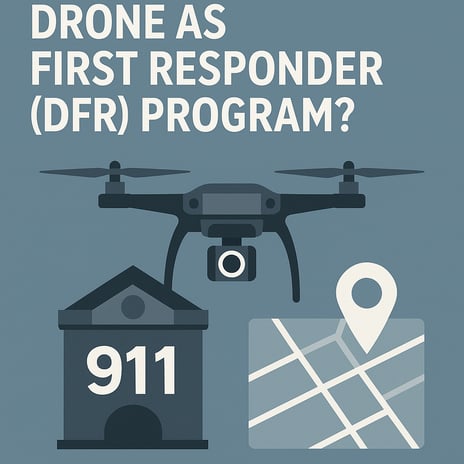
What Is a Drone as First Responder Program?
Reimagining Emergency Response from the Sky In today’s fast-paced world, where seconds can mean the difference between life and death, innovation in emergency response is more critical than ever. Enter the Drone as First Responder (DFR) Program—a revolutionary approach transforming how cities and agencies respond to emergencies. From crime scenes to car crashes, missing persons to natural disasters, drones are quickly becoming the first eyes on scene, and in many cases, the most valuable.
Dakota Smith
5/29/20252 min read



DFR Defined: More Than Just Drones in the Air
The Drone as First Responder concept is exactly what it sounds like: deploying drones as the first units to respond to emergency calls. Unlike traditional drone usage where pilots arrive on scene and manually launch, DFR systems are strategically pre-positioned and often remotely piloted. This allows them to reach an incident within 60–90 seconds, often before patrol cars or fire engines arrive.
DFR programs are typically operated by law enforcement or public safety agencies and are integrated into 911 dispatch systems. As soon as a call is received, the nearest drone is launched autonomously or by a remote pilot, providing live video feeds to officers, dispatchers, and command staff.
Key Features of a DFR Program
Rapid Deployment: Drones are launched from rooftop docks or designated stations throughout the city, cutting travel time significantly.
Live Streaming: Video is transmitted in real time to command centers or mobile units, improving situational awareness.
Remote Piloting: FAA-authorized programs can fly drones Beyond Visual Line of Sight (BVLOS), allowing full control from a remote operations center.
Multi-Agency Use: Fire, EMS, and police departments all benefit from drone footage—whether it’s finding a suspect, spotting a fire’s point of origin, or locating a missing child in dense terrain.
Why It Matters
Improved Officer Safety: Officers can assess threats from a safe distance before making contact.
Faster Resource Allocation: Command staff can determine if an incident requires more units or can be handled with fewer resources.
Evidence Documentation: Drones can begin recording from the moment they arrive, preserving an unaltered view of the scene.
De-escalation Tool: In some cases, suspects who see they're being observed from above comply without incident, avoiding unnecessary confrontations.
Cities Leading the Charge
Several cities across the U.S. have already adopted DFR programs with great success:
Chula Vista, CA: The pioneer of the DFR model, responding to over 20,000 calls with drones.
Brookhaven, GA: First in the Southeast with FAA-approved BVLOS authority.
Fremont, CA and Schenectady, NY: Rapidly scaling DFR programs with integrated fire and police use.
Asheville, NC: Implementing drone docking stations tied directly to 911 response systems.
Challenges and Considerations
Despite its benefits, DFR isn’t without hurdles:
FAA Regulations: Agencies must obtain special waivers, especially for BVLOS flights.
Privacy Concerns: Transparency and public trust are vital. Clear use policies, flight logs, and community engagement are essential.
Cost and Infrastructure: DFR programs require significant investment in technology, training, and airspace management.
The Future of First Response
As drone technology evolves, so will DFR programs. Advances in AI, autonomous navigation, and 5G connectivity are making real-time aerial response more accessible and powerful. We’re entering a new era where the first person on scene may not be a person at all—but a set of intelligent rotors and sensors with a direct line to those who protect and serve.

Peak Perspective LLC
Your partner in photography and content creation.
Contact us
info@peakperspectivellc.pro
(470) 206-8950
© 2025. All rights reserved.

